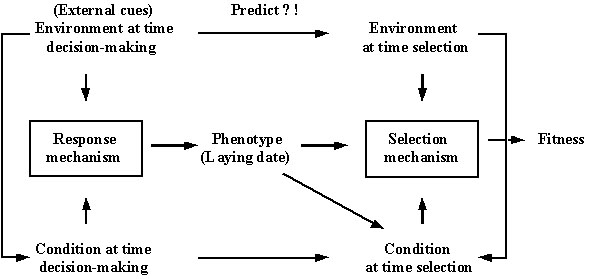
S05.Summary: Proximate aspects of the timing of reproduction
Marcel M. Lambrechts1 & Marcel E. Visser2 1CEFE-CNRS, B.P. 5051, F-34293 Montpellier cedex 5, France, fax 33 467412138, e-mail lambrechts@cefe.cnrs-mop.fr; 2Netherlands Institute of Ecology, PO Box 40, 6666 ZG Heteren, The Netherlands, fax 31 26 4723227, e-mail m.visser@cto.nioo.knaw.nlLambrechts, M.M. & Visser, M.E. 1999. Proximate aspects of the timing of reproduction. In: Adams, N.J. & Slotow, R.H. (eds) Proc. 22 Int. Ornithol. Congr., Durban: 231-233. Johannesburg: BirdLife South Africa.
The timing of reproduction is one of the reproductive traits with the greatest impact on fitness. Birds match their timing of reproduction with a brief moment in the year when food to raise the young is most plentiful. A naturally and/or experimentally induced change of the close link between the timing of parental care, brood size, and the time of maximum food availability can reduce offspring condition/survival considerably. We term the processes that translate a reproductive decision (e.g. onset of egg laying) into fitness consequences the selection mechanism (Fig. 1). This mechanism is influenced both by the environment at the time of selection, represented by the total amount of food available to raise the young, and by the physical condition of the parents, affecting the amount of parental care. Food availability after decision-making and at the time of selection may affect the physical condition and capacity of the parents to raise a brood. The selection mechanism is often poorly understood. This is chiefly because few long term ecological studies quantify potentially important sources of selection, such as food for the young. Furthermore, reliable measures of fitness are difficult to obtain.
The start of gonad development occurs several weeks before the young are raised. The timing of gonad and egg development are proximately determined by physiological mechanisms that allow responses to external cues that ‘ predict’ the environment at the time of selection, i.e. the optimal time to raise the young (Fig. 1). Gonad and egg formation is energetically expensive. The responses to external cues are therefore influenced by the physical condition of the parents. The external cues that predict the environment of selection, such as food to form eggs, may have short term effects on the capacity to invest in gonad and egg formation and/or long term effects on the capacity to raise the young. We expect that the response mechanisms are under strong selection because they assure a close matching between the timing of reproduction and the optimal breeding time even when circumstances differ between years and areas. Timing of reproduction can therefore be viewed as a decision with major fitness consequences, but for which the organisms are information constrained.
Species, populations or individuals within populations are exposed to different habitats with much spatio-temporal variations in the optimal breeding time. This explains why birds evolved over many generations different response mechanisms to a series of cues that predict these variations in optimal breeding time, such as photoperiod, ambient temperature, or food to form eggs. On one hand, a single response mechanism exposed to different environmental cues may result in different reproductive decisions describing the reaction norm of the response mechanism. Steep reaction norms, i.e. much plasticity in the reproductive decision, are assumed to evolve in organisms exposed to much temporal and spatial variations in the environment at the time of selection. On the other hand, different response mechanisms resulting in different reaction norms may evolve if different organisms are exposed to consistent year-to-year differences in their environment of selection. Whether groups of individuals within/between local study plots show differences in timing of reproduction because of individual variations in response mechanisms, because of variations in the availability of cues, and/or because of variations in resource availability to form gonads or eggs remains unclear. Understanding proximate and ultimate aspects of reaction norms of reproductive decisions therefore requires long term studies at different spatial and temporal scales.
Physiologists working on response mechanisms leading to reproductive decisions in the timing of reproduction rarely or not collaborate with ecologists looking at selection mechanisms and fitness consequences of reproductive decisions. We are not aware of any case study that looked at the same time at ecological and physiological aspects of response and selection mechanisms and fitness consequences of these mechanisms in the framework of long term studies at different spatial and temporal scales. These kind of multidisciplinary studies are however crucial for a full understanding of the huge variation in the timing of reproduction that exists within and between bird species. The goal of this symposium was to bring together ecologists working at fitness consequences and selection pressures and physiologists examining the timing and speed of gonad and egg formation, and hormones related to these developmental processes. The different papers present studies of different biological models exposed to different environments (Parus spp., Taeniopygia guttata, Zonotrichia leucophrys spp.). They present comparative (intraspecific vs. interspecific) and experimental (laboratory, aviary, field manipulations of lay dates) studies of different stages in timing of reproduction (gonad development, egg development, onset of egg laying, reproductive success). The symposium can be considered as a first step toward a more integrated approach of the study of the timing of reproduction.
Fig. 1. The timing of reproduction results from responses of organisms to external cues and the physical condition of the parents at the time of gonad and egg formation. The proximate response mechanisms in combination with the physical condition of the parents determine how external cues are transformed into a reproductive decision, such as the start of egg laying. The laying date and offspring stage is transformed in ‘fitness components’ by a selection mechanism which is determined by the environment at the time of selection and the physical capacity of the parents to take care for the young. Physiologists may help to understand proximate response mechanisms, whereas ecologists may help to understand selection mechanisms.
